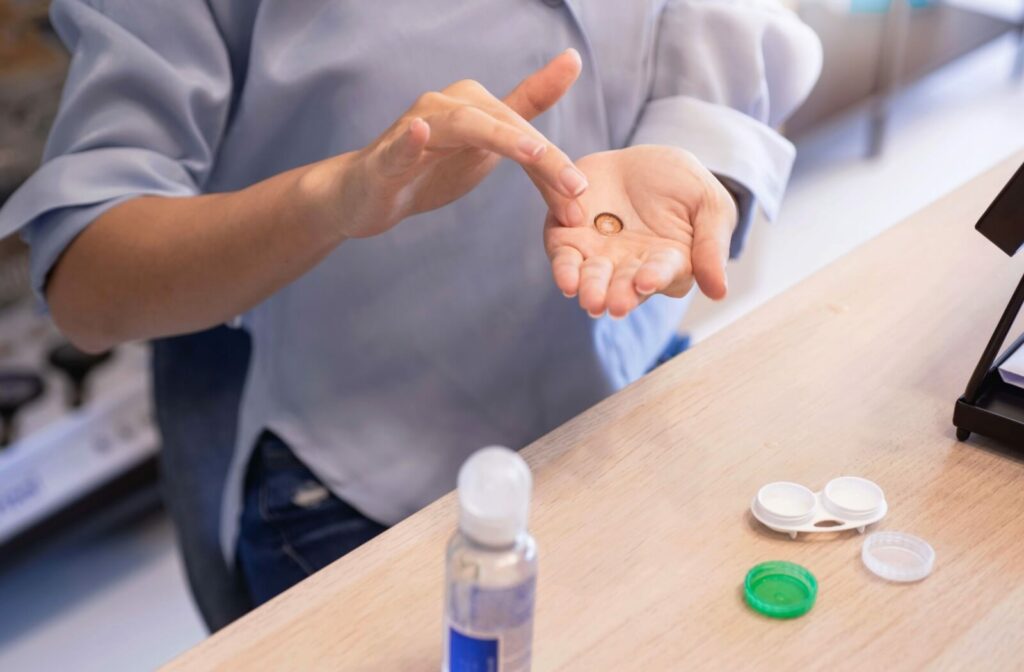Pink eye is a common condition affecting individuals of all ages. It results in red eyes, excessive tearing, and discharge. For contact lens wearers, the resulting discomfort is often aggravated, as continuing to wear lenses can further irritate the eyes, preventing further healing.
During pink eye flare-ups, ditching your contact lenses for eyeglasses is strongly advised. Switching to glasses helps prevent further discomfort and reinfection, and promotes further healing.
Once the infection has cleared and you’ve been given the green light to continue wearing contacts by your eye doctor, it’s vital to dispose of any contaminated lenses. Use a fresh new pair, and practice proper contact lens care.
Understanding Conjunctivitis
Conjunctivitis, also known as pink eye, is a prevalent eye condition that inflames the conjunctiva, the clear tissue covering the white part of the eye and the inside the eyelids.
This condition is marked by redness in the eye (hence its name), discomfort, and itching. Pink eye can be particularly disruptive for contact lens wearers, as it often necessitates changes in their wear and care routine.
Symptoms can vary depending on the strain, but commonly include:
- Redness
- Excessive tearing
- Green or white discharge
- Light sensitivity
- Blurry vision
- Itchy eyes
There are different types of conjunctivitis, each requiring different treatment and management strategies:
- Viral Conjunctivitis: Highly contagious and often associated with upper respiratory tract infections or the common cold.
- Bacterial Conjunctivitis: More common in children than adults, and is caused by a bacterial infection that can be transmitted through direct contact with infected individuals or by sharing personal items.
- Allergic Conjunctivitis: Caused by allergens like pollen, dander, smoke, or chlorine that trigger an allergic reaction. This variety isn’t contagious.
Pink eye isn’t considered serious, but it can lead to severe complications that pose risks to ocular health if left untreated. Plus, viral and bacterial varieties of pink eye are highly contagious. Proper management aids in recovery and prevents any potential infection from spreading.

Avoid Wearing Contacts with Conjunctivitis
Regardless of the type of pink eye they have, individuals are strongly advised to avoid wearing contact lenses during an active case, as contacts can exacerbate irritation and impede recovery. Therefore, switching to glasses until the condition has resolved is strongly recommended.
Contact lenses create a barrier over the eye, trapping bacteria, viruses, allergens, and other irritants, aggravating ongoing inflammation and increasing the severity of the infection. Even after contacts are removed, they may retain irritants on their surface, which may lead to infection if the lenses are worn again. This can create an endless cycle of discomfort.
Additionally, the friction between contact lenses and the inflamed conjunctival tissues heightens discomfort, further irritating the eye’s surface.
Ultimately, symptoms associated with pink eye can worsen while wearing contact lenses, slowing down the healing process.
Improper lens hygiene, such as not cleaning lenses regularly or failing to replace them as recommended, can contribute to developing conjunctivitis. Inadequate care creates an attractive environment for pathogens to accumulate on the lens, from which they can be transferred to the eye’s surface.
The importance of never sharing contact lenses cannot be overstated. Sharing lenses heightens the risk of cross-contamination, as infectious agents can be transferred from one person to another, resulting in conjunctivitis or other severe eye infections.
Following proper contact lens care can reduce the likelihood of developing conjunctivitis. Good contact lens care includes:
- Washing your hands before handling lenses.
- Using saline solution to clean lenses and not water.
- Following lens replacement and adhering to wear schedules.
- Replacing your contact lens container every three months.
After a flare-up of pink eye (and after getting the green light from your optometrist), it’s vital to dispose of any potentially contaminated lenses and start with a fresh new pair. This helps prevent reinfection and promotes healing.
Treating Conjunctivitis
Pink eye can be cured effectively. The goal of treatment focuses on relieving symptoms and preventing complications while promoting recovery.
Visiting your optometrist is a key step in treating conjunctivitis, because an accurate diagnosis helps determine the most appropriate treatment plan for each patient.
- Viral Conjunctivitis: Often resolves on its own without the need for specific treatments. Supportive measures like applying cool compresses or using artificial tears can help alleviate discomfort.
- Bacterial Conjunctivitis: Antibiotic eye drops or ointments are commonly prescribed to target bacterial infections. These antibiotics work by inhibiting bacterial growth or killing bacteria directly, quickly alleviating symptoms.
- Allergic Conjunctivitis: Addressing the underlying allergy is key. Antihistamine eye drops can reduce itchiness and swelling by blocking the substances that trigger allergic reactions. Identifying and avoiding exposure to allergens can help prevent future flare-ups.
Regardless of the type of pink eye, at-home remedies can provide significant relief from irritation and discomfort:
- Cold Compress Mask: Alleviates swelling and irritation, soothing the eyes. Soak a clean cloth in cold water, wring it out, and apply it gently over closed eyelids for several minutes.
- Warm Compress Mask: Helps loosen the crust around the eyelids associated with bacterial conjunctivitis. Use warm water to soak a cloth before wringing out excess water, applying it over the eyelids for several minutes.
- Artificial Tears: These tears mimic the natural composition of tears to hydrate the eyes, helping to wash away irritants and reducing the gritty sensation associated with pink eye. Use preservative-free drops throughout the day for ongoing relief.
Following proper hygiene practices should be used in conjunction with these management strategies, which include:
- Frequent hand-washing.
- Avoid touching and rubbing the eyes.
- Avoid wearing eye makeup.
- Not sharing personal items like towels and eye drops.
Schedule a Visit
Pink eye can be resolved completely by following appropriate treatment and care. This includes switching from contacts to glasses to prevent further irritation, worsening symptoms, and reinfection.
If you feel the onset of eye discomfort and irritation, connect with our team at Focus West Optometry to schedule an appointment.



